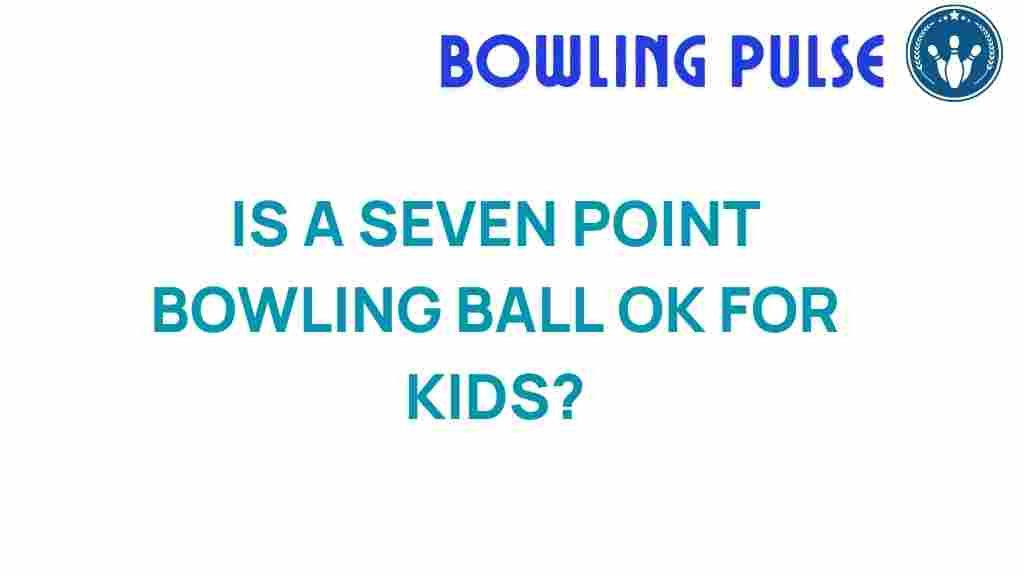Is a Seven-Point Bowling Ball Safe for Young Bowlers? – Understanding Bowling Safety
Bowling is a fantastic sport for kids, promoting physical activity, coordination, and social skills. As parents, ensuring the safety of our children while they engage in sports is paramount. One question that often arises among parents is whether a seven-point bowling ball is safe for young bowlers. In this article, we’ll explore bowling safety, the features of a seven-point ball, and how to choose the right bowling equipment for youth bowling.
Understanding the Seven-Point Bowling Ball
A seven-point bowling ball, specifically designed for youth bowling, typically weighs seven pounds. This weight is ideal for young bowlers who are just starting, as it allows them to learn the fundamentals of the game without straining their muscles. When discussing bowling safety, it’s crucial to consider the weight of the bowling ball as it directly impacts the bowler’s ability to control it effectively.
Benefits of Using a Seven-Point Ball
- Lightweight and Manageable: A seven-point ball is easy for kids to lift, throw, and control, reducing the risk of injury.
- Promotes Proper Technique: With a lighter ball, young bowlers can focus on developing their form and technique without overexerting themselves.
- Encourages Participation: A lighter ball can help hesitant young bowlers feel more confident and willing to participate in the sport.
Choosing the Right Bowling Equipment for Youth Bowling
When considering bowling equipment for young bowlers, several factors come into play to ensure safety and enjoyment. Here are some essential tips for parents:
1. Select the Appropriate Ball Weight
As mentioned earlier, the weight of the bowling ball is critical. A seven-point bowling ball is generally suitable for children aged 7 to 10 years old, but always consider your child’s strength and experience level. Here’s a quick guide:
- Children under 5 years: 6 pounds or lighter
- Ages 5-7: 6-7 pounds
- Ages 8-10: 7-9 pounds
- Ages 11 and up: 10 pounds and above
2. Invest in Child-Friendly Gear
Aside from the bowling ball, appropriate child-friendly gear is essential. Consider the following:
- Bowling Shoes: Proper bowling shoes provide the necessary grip and support. Make sure they fit well and are designed for children.
- Finger Inserts: If your child is using a drilled ball, consider finger inserts to improve grip and comfort.
- Bowling Gloves: A good bowling glove can help with grip and prevent blisters.
3. Ensure Proper Bowling Technique
Teaching your child the basics of bowling technique is essential for both safety and performance. Here are some bowling tips to keep in mind:
- Start with the right stance; feet should be shoulder-width apart.
- Encourage a smooth swing and release; avoid using excessive force.
- Focus on aiming for the arrows on the lane rather than the pins.
Bowling Safety: Supervision and Environment
In addition to choosing the right equipment, bowling safety involves ensuring a safe bowling environment. Here are some considerations:
1. Supervise Young Bowlers
Always supervise young bowlers, especially those who are just starting. Supervision can help prevent accidents and ensure that children are following safe practices while bowling.
2. Choose Family-Friendly Bowling Alleys
Look for bowling alleys that cater specifically to families and children. These alleys often have safety measures in place, such as:
- Bowling bumpers to prevent gutter balls
- Child-sized lanes
- Staff trained in youth bowling safety
3. Know the Bowling Etiquette
Teaching children the rules of bowling etiquette can enhance their experience and ensure a respectful environment. Important points include:
- Wait for the bowler in the next lane to finish before stepping onto the approach.
- Respect the equipment and lanes.
- Understand personal space; avoid crowding the bowler.
Troubleshooting Common Issues in Youth Bowling
Even with the best preparations, issues can arise. Here are some common problems and how to troubleshoot them:
1. Difficulty Lifting the Ball
If your child struggles to lift the seven-point bowling ball, consider:
- Trying a lighter ball if available.
- Practicing strength-building exercises to improve their lifting ability.
- Ensuring they have the proper grip and technique.
2. Poor Bowling Performance
If your child is not performing well or seems frustrated, consider the following:
- Review their technique and make adjustments as needed.
- Encourage practice to build confidence.
- Make bowling a fun, pressure-free experience.
3. Safety Concerns
If you notice your child exhibiting signs of discomfort or fatigue, take a break. Pay attention to the following:
- Signs of muscle strain or discomfort.
- Fatigue or loss of interest in the game.
- Any accidents or near misses while bowling.
Conclusion: Promoting Safe and Fun Bowling for Kids
In conclusion, a seven-point bowling ball can be a safe and effective choice for young bowlers when paired with the right practices and equipment. Ensuring bowling safety involves choosing appropriate bowling equipment, supervising children, and teaching them proper techniques. By following the guidelines outlined in this article, parents can foster a positive bowling experience for their children.
For more resources on youth sports and bowling, check out this helpful guide. Remember, the goal is not only to improve skill but also to ensure that kids enjoy their time in the lanes!
For further reading on child safety in sports, visit this external resource.
This article is in the category Equipment and created by BowlingPulse Team
